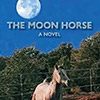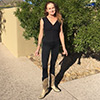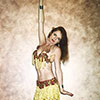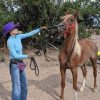Last summer, before I met Zum, I had my heart set on adopting an Arabian mare. She was brown with a black mane and tail. She hadn’t been ridden in years as her owner could no longer ride her. The owner told me she was looking for a good home for the mare. I invited my girlfriend to meet the mare and my girlfriend noticed that the mare was cribbing. The mare was grabbing the metal fence with her teeth. We could hear the mare sucking air in through her open mouth as she pulled back on the fence, over and over. I researched cribbing later and discovered that cribbing is a sign of something wrong with the horse’s mental and physical environment. It is the horse’s way to cope with stress or the way the horse is handled. Confined horses that are not ridden often suffer from cribbing which can cause gastric ulcers. The owner decided to keep the mare after all. But I learned how important it is for every horse to be in an environment without stress. Every horse needs social contact with other horses or companion animals. Every horse needs to be exercised with the ability to move around. Every horse needs toys to play with like rubber balls. I fill a plastic jug full of rocks and hang it from the corral for Zum to toss around. And every horse needs a salt lick. I am so happy that Zum has my other horses to play with! He also has my miniature pony and miniature donkey. Zum adores them!
Month: July 2019
Everyday
I know that Zum gets bored and stressed when I don’t handle him everyday. He needs daily grooming, training, exercise and fun! Not doing anything with Zum is worse than doing something and making a mistake. Mistakes are opportunities for me to try again! So I am teaching Zum lots of tricks! I am teaching him to walk on a tarp, stop and then back up. A tarp is very scary for horses. It blows around like a plastic bag and it makes noises when it is touched. I am showing Zum that he can be brave standing on a tarp. I also put the tarp all over his body and even drape it on his back. I am teaching him to walk on a wooden platform and stop. I am teaching him to drop his head and touch orange cones with his nose. I tied a plastic bag at the end of a long whip. I wave the plastic bag in the air and around his feet, asking him to be calm. I put shipping boots on and off all his legs. I even put a shipping hat on his head, which he didn’t like at first! I am showing him how to walk in and out of a stock trailer. When he gets nervous, I have him do something that he loves to do and praise him for what he can do. Every lesson ends with him doing what he can do so he feels good about himself. He is learning that he can trust me to do what I ask him. My praise reinforces his feeling that I am not a threat. He wants me to be proud of him!
Ballerina
Last night, I went to see the Santa Fe Aspen Ballet in Santa Fe. Seeing the ballet dancers perform reminded me of my own ballerina history. When I was five years old, my grandmother Helena took me to see a movie about a young ballerina in the Royal Danish Ballet. The movie is called Ballerina. After seeing this movie, I knew that I wanted to be a ballerina. By the time I was sixteen, I was a ballerina. Years of study and dedication manifested my dream. I loved ballet as much as I loved my Arabian stallion named Khalifah that I rode everyday after school. I was accepted into the Royal Danish Ballet school and after I graduated from High School, I went to Copenhagen, Denmark. Yes, studying with the Danish ballet was a dream come true. At seventeen years old, I even met and got to know the star of the movie Ballerina. Now she was my teacher! But there were behind the scene things that I saw about the world of ballet that I didn’t enjoy. I missed my Arabian stallion back in Santa Fe! I missed my mother and I missed the sunshine. The winter in Copenhagen was dark and for months, noon was as black as midnight. I learned a lot the year I lived in Denmark and traveled through Europe. But my heart was with my elegant Arabian stallion in Santa Fe!
Pony
I decide it is time to pony my colt off my racehorse! A few years ago, I rescued an Egyptian Arabian racehorse named Huszar. Huszar is big and muscular. All I have to say is ‘Go!’ and from a complete stop, he will charge forward into a full gallop! He is an alpha-male with a powerful personality. Yet, I can train people how to ride on him as he is very patient and gentle with people. He doesn’t bite, buck, rear or kick. He is a solid horse when I train and trail ride with beginner riders. As I ride Huszar, I am sure he can teach Zum how to follow on a lead rope behind him. Yes, my hunch is correct! Right away, after I jumped on Huszar, he was putting his ears back and swishing his tail whenever Zum walked too far ahead or got too close to us. We rode together for an hour and what a joy! My colt was so happy to be out of his corral and I was in heaven to be out riding in the mountains with my racehorse and my colt!
Why?
Zum loves to be in my space all the time. Also, when I lead him with a lead rope, his natural response is to resist pressure or to stiffen up and refuse to move. A bad trainer resists back. Then, the colt becomes frightened and resists harder. A bad trainer uses an ever increasing level of fear and pain to control behavior. Pain is used as the motivator and punishment is a bad trainer’s tool. Punishment used after behavior is terrible timing, only negatively reinforcing bad behavior. Why punish a young colt like Zum? I need him to learn that he doesn’t need to be on top of me all the time but if I punish him, he may stop coming to greet me when I show up. Punishment produces bad side effects. With punishment, my colt may start to pace in his corral. He could become aggressive and begin to kick or lunge at me. All trust would be lost between us and he would begin to hate me. Punching, whipping, shanking and hitting a horse crosses the line into abuse. Good trainers shift away from punishment. Instead of punishment, I can use well-timed and well-applied reinforcers. I want to teach my colt to move away from pressure. I can touch his ribs and ask him to move away. I can raise my elbow if Zum tries to crowd me. Good training is preventative. If I get my colt’s feet busy and get him to focus back on me and his lesson, I can get him to relax and prevent bad behavior in the future.
Excellence

I read this pearl of wisdom: ‘Live your life in a state of excellence!’ This makes me think. What is excellence in my life now? I have my colt focused on good behavior as he loves his treats and scratches. I am paying attention to my verbal cues to my colt, saying in a matter of fact voice ‘wrong’ when he does something he isn’t supposed to do. I never say ‘no.’ I never use an angry tone of voice with him. I simply reach out my arm and let my colt bump into my elbow if I need space from him. I say ‘touch’ if I teach him a new trick and I reward him immediately when he learns. And he is learning quickly! I am teaching him my voice cues for direction changes. Stop is ‘Ho’ and go is the kiss sound. Back up is ‘ch-ch-ch’ and humming softly means he can relax. I also put my hand on his nose and keep it there until he is calm. Then I let go and let him have a moment of release from asking him anything. We are both enjoying our moments together of satisfied quiet. I think this is excellence!
Dream
If I can dream it, I can train it! Wise words to remember while training a wild colt! I can take out my mind the behavior I don’t want and visualize only on the behavior I do want. So what do I want? A colt that is friendly, calm, relaxed, patient, happy and open. If I was a student, which teacher would I rather have? The teacher that is feeling angry and hostile? Or the teacher who is friendly and relaxed? This is an easy answer. A teacher that is friendly and relaxed. So I realize I want the same thing for Zum and myself!
To be Zum’s teacher
My favorite line in a book that I read is: Horses need teachers, not bullies. I don’t want to muscle my way through problems. I don’t want to shove or push my colt. I don’t want to pull and yank on his head, drag him around or haul him into a halt. I don’t want to yell at him or punish him. I want to treat Zum with patience and care. I want to reinforce all his good behavior with a loving rub on his neck. I found out how much Zum loves the feel of a stroke or scratch on his neck. I learned that I need to do every lesson with Zum in small steps. I can engage Zum’s mind not his muscle. I can put my colt in a learning situation where his head is never jerked on. I can touch him on his shoulder to teach him to soften to pressure and move over. The same is true for his hip and ribs. I want every inch of his body to respond to my touch. I can pair correct responses with lots of verbal praise. He will be learning to be a light, responsive horse who knows when he is good!
Lessons of Love
As I read the horse training books, I learned important lessons of love. These lessons were the inspiration that made me believe I could train this wild colt myself. In this life, if I cannot do great things, I can do small things with great love. During my small acts of horse training, my colt and I have the potential to give and receive great love. I can look inside myself and offer my colt the best of myself. In each training session, I can bring out joy in myself and in my colt. I must give the best of myself before I expect my colt to offer the best of himself to me. Negativity gets in the way of the growth of my colt. I must focus on the good things that I want my colt to learn. I always remember what the vet told me before I bought Zum. This colt wants to be good. I just need to teach him how!
Finding Zum
 On August 25 last year, I brought home a beautiful Arabian 2 year colt that I found outside of Albuquerque. The vet that did the prepurchase exam told me this colt ‘wanted to be good but didn’t know how.’ Yes, this is Zum, my wild colt! I hired three trainers, one after the other. I never planned to train this young colt myself. I even had the colt set up to be boarded and trained at a reputable trainer’s ranch! Well, everything fell through. I ended up with a untrained colt and library books I borrowed from the Santa Fe Public Library! The first book I read taught me that horse’s actions reflect how they feel. A horse’s body is a mirror for his emotions. So I realized that my colt’s body informs me of what is going on internally. My colt’s actions supply me with information. I learned that punishment only reinforces the one who punishes. I do not want to punish my inexperienced colt! I want my colt to learn that being close to me isn’t all that bad!
On August 25 last year, I brought home a beautiful Arabian 2 year colt that I found outside of Albuquerque. The vet that did the prepurchase exam told me this colt ‘wanted to be good but didn’t know how.’ Yes, this is Zum, my wild colt! I hired three trainers, one after the other. I never planned to train this young colt myself. I even had the colt set up to be boarded and trained at a reputable trainer’s ranch! Well, everything fell through. I ended up with a untrained colt and library books I borrowed from the Santa Fe Public Library! The first book I read taught me that horse’s actions reflect how they feel. A horse’s body is a mirror for his emotions. So I realized that my colt’s body informs me of what is going on internally. My colt’s actions supply me with information. I learned that punishment only reinforces the one who punishes. I do not want to punish my inexperienced colt! I want my colt to learn that being close to me isn’t all that bad!


















